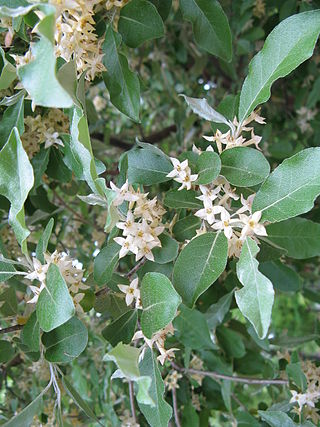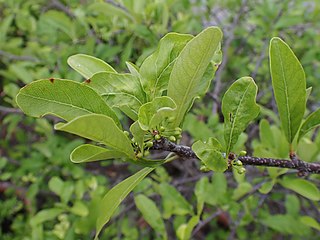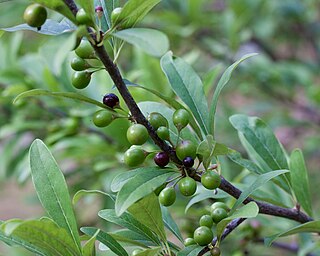
Spanish moss is an epiphytic flowering plant that often grows upon large trees in tropical and subtropical climates. It is native to much of Mexico, Bermuda, the Bahamas, Central America, South America, the Southern United States, and West Indies. It has been naturalized in Queensland (Australia). It is known as "grandpa's beard" in French Polynesia. It has the widest distribution of any bromeliad.

Acer saccharinum, commonly known as silver maple, creek maple, silverleaf maple, soft maple, large maple, water maple, swamp maple, or white maple, is a species of maple native to the eastern and central United States and southeastern Canada. It is one of the most common trees in the United States.

Elaeagnus umbellata is known as Japanese silverberry, umbellata oleaster, autumn olive, autumn elaeagnus, spreading oleaster, autumnberry, or autumn berry. The species is indigenous to eastern Asia and ranges from the Himalayas eastwards to Japan. It is a hardy, aggressive invasive species able to readily colonize barren land, becoming a troublesome plant in the central and northeastern United States and Europe.

Magnolia macrophylla, the bigleaf magnolia, is a deciduous magnolia native to the southeastern United States and eastern Mexico. This species boasts the largest simple leaf and single flower of any native plant in North America.

Eucalyptus sideroxylon, commonly known as mugga ironbark, or red ironbark is a small to medium-sized tree that is endemic to eastern Australia. It has dark, deeply furrowed ironbark, lance-shaped adult leaves, flower buds in groups of seven, white, red, pink or creamy yellow flowers and cup-shaped to shortened spherical fruit.

Cornus alternifolia is a species of flowering plant in the dogwood family Cornaceae, native to eastern North America, from Newfoundland west to southern Manitoba and Minnesota, and south to northern Florida and Mississippi. It is rare in the southern United States. It is commonly known as green osier, alternate-leaved dogwood, and pagoda dogwood.

Sideroxylon is a genus of trees in the family Sapotaceae described as a genus by Linnaeus in 1753. They are collectively known as bully trees. The generic name is derived from the Greek words σιδηρος (sideros), meaning "iron", and ξύλον (xylon), meaning "wood."

Sideroxylon lanuginosum is a shrub or small tree of the family Sapotaceae. It is native to the Sun Belt and Midwest of the United States as well as Northeastern Mexico. Common names include gum bully, black haw, chittamwood, chittimwood, shittamwood, false buckthorn, gum bumelia, gum elastic, gum woolybucket, woolybucket bumelia, wooly buckthorn, wooly bumelia, ironwood and coma.

Sideroxylon lycioides, the buckthorn bully, is a small tree in the family Sapotaceae. It is widely distributed in the southeastern United States from Texas to southeast Virginia.

Ilex decidua is a species of holly native to the United States.

Eucalyptus tricarpa, commonly known as red ironbark or mugga ironbark, is a species of tree that is endemic to south-eastern Australia. It has thick, rough ironbark on the trunk and branches, lance-shaped adult leaves, flower buds usually in groups of three, white flowers and cylindrical or spherical fruit.

Tsuga dumosa, commonly called the Himalayan hemlock or in Chinese, Yunnan tieshan, is a species of conifer native to the eastern Himalayas. It occurs in parts of Nepal, India, Bhutan, Myanmar, Vietnam and Tibet. Within its native range the tree is used for construction as well as for furniture. In Europe and North America, it is occasionally encountered as an ornamental species and was first brought to the United Kingdom in 1838.

Rhamnus cathartica, the European buckthorn, common buckthorn, purging buckthorn, or just buckthorn, is a species of small tree in the flowering plant family Rhamnaceae. It is native to Europe, northwest Africa and western Asia, from the central British Isles south to Morocco, and east to Kyrgyzstan. It was introduced to North America as an ornamental shrub in the early 19th century or perhaps before, and is now naturalized in the northern half of the continent, and is classified as an invasive plant in several US states and in Ontario, Canada.

Frangula alnus, commonly known as alder buckthorn, glossy buckthorn, or breaking buckthorn, is a tall deciduous shrub in the family Rhamnaceae. Unlike other "buckthorns", alder buckthorn does not have thorns. It is native to Europe, northernmost Africa, and western Asia, from Ireland and Great Britain north to the 68th parallel in Scandinavia, east to central Siberia and Xinjiang in western China, and south to northern Morocco, Turkey, and the Alborz in Iran and the Caucasus Mountains; in the northwest of its range, it is rare and scattered. It is also introduced and naturalised in eastern North America.
Sideroxylon salicifolium, commonly called white bully or willow bustic, is a species of flowering plant native to Florida, the West Indies and Central America.

Eucalyptus flocktoniae, commonly known as merrit, is a species of tree or mallee that is endemic to Western Australia. It has smooth, silvery grey bark, lance-shaped to curved adult leaves, prominently beaked flower buds in groups of seven or nine and barrel-shaped or urn-shaped fruit.

Viburnum rufidulum, also known as the rusty blackhaw, blue haw, rusty nanny-berry, or southern black haw, is a flowering species of shrub or small tree that is common in parts of the Eastern and Central United States. It produces attractive flowers and fall foliage, as well as fruits that are popular with some species of bird.

Catalpa ovata, the yellow catalpa or Chinese catalpa, is a pod-bearing tree native to China. Compared to C. speciosa, it is much smaller, typically reaching heights between 20 and 30 feet. The inflorescences form 4–10-inch-long (100–250 mm) bunches of creamy white flowers with distinctly yellow tinging; individual flowers are about 1 inch (25 mm) wide. They bloom in July and August. The leaves are very similar in shape to those of Paulownia tomentosa, having three lobes, and are darkly green. Fruits are very narrow, foot-long pods.

Sideroxylon tenax, called the tough bully, is a plant species native to Florida, Georgia, South Carolina and the southernmost part of North Carolina. It grows on dry, sandy soil in pine forests, pine-oak woodlands, and hummocks at elevations less than 100 m.
Sideroxylon reclinatum subsp. austrofloridense, known as the Everglades bully, is a species of rare plant native to southern Florida. It was described in 1990.

















